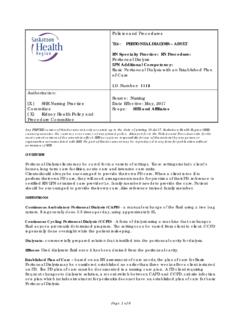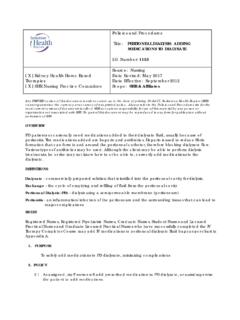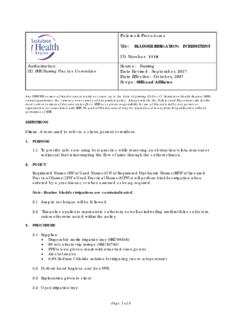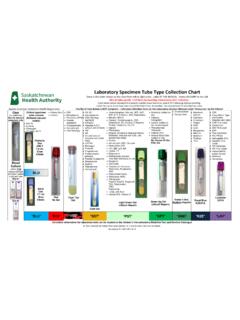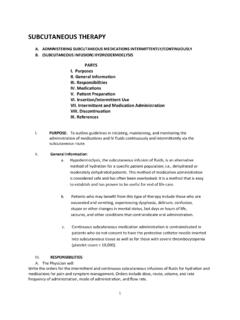Transcription of SUBCUTANEOUS THERAPY - INTERMITTENT AND …
1 Page 1 of 17 Any PRINTED version of this document is only accurate up to the date of printing 13-May-19. Saskatoon Health Region (SHR) cannot guarantee the currency or accuracy of any printed policy. Always refer to the Policies and Procedures site for the most current versions of documents in effect. SHR accepts no responsibility for use of this material by any person or organization not associated with SHR. No part of this document may be reproduced in any form for publication without permission of SHR. For the purpose of this policy, client will be used when referring to clients, patients and residents. DEFINITIONS BD Saf-T-Intima An indwelling SUBCUTANEOUS catheter device used for SUBCUTANEOUS administration of medication or fluid, either as a continuous infusion or for breakthrough/bolus doses. Hypodermoclysis (HDC) Refers to the SUBCUTANEOUS administration of fluid and electrolytes for the treatment and prevention of mild to moderate dehydration.
2 For all other uses, the term SUBCUTANEOUS THERAPY should be used. Insuflon An indwelling SUBCUTANEOUS catheter device used for frequent SUBCUTANEOUS administration of medication. This device requires a needle and syringe to administer medication. Preparatory Information Refers to procedural and sensory information provided to the client prior to a procedure. Procedural information includes a description of the steps of the procedure. Sensory information includes a range of what the client may feel during the procedure. SUBCUTANEOUS THERAPY Refers to the establishment of SUBCUTANEOUS access for repeated/ INTERMITTENT medication doses and/or continuous SUBCUTANEOUS infusion of medication. ROLES Graduate Nurses (GNs) and Graduate Licensed Practical Nurses (GLPNs) will practice SUBCUTANEOUS THERAPY under the direct supervision of an RN or LPN until deemed competent. Registered Nurses (RNs) and Licensed Practical Nurses (LPNs) will: Initiate and maintain INTERMITTENT SUBCUTANEOUS access Administer INTERMITTENT SUBCUTANEOUS medication via established access Initiate and maintain continuous SUBCUTANEOUS infusions (medications/fluids) Policies and Procedures Title: SUBCUTANEOUS THERAPY - INTERMITTENT AND continuous ADULT & PEDIATRIC RN AND LPN ENTRY LEVEL COMPETENCY Number: 1074 Authorization: [X] Former SKtnHR Nursing Practice Committee Source: Nursing Date Revised: March 28, 2018 Date Effective: January 2000 Scope: SKtnHR & Affiliates Policies & Procedures: SUBCUTANEOUS THERAPY INTERMITTENT and continuous # 1074 Page 2 of 17 Registered Psychiatric Nurses (RPNs) the role of RPNs with SUBCUTANEOUS THERAPY is under review by the Nursing Practice Committee.
3 RPNs who are currently educated or certified in SUBCUTANEOUS THERAPY may continue to provide care. New RPNs will not be educated or certified to provide SUBCUTANEOUS THERAPY until the review is completed. 1. PURPOSE To guide safe practice associated with the insertion and maintenance of SUBCUTANEOUS THERAPY and HDC. To prevent infections and other complications associated with SUBCUTANEOUS THERAPY and HDC. 2. POLICY An accurate and complete allergy/intolerance history must be obtained or verified prior to prescribing, dispensing or administering any medications as per SHR Regional policy Allergy/Intolerance Documentation #7311-60-029. A practitioner order is required for medication/fluid THERAPY as per SHR Regional policy Ordering of Medications #7311-60-004. Verification of client identification will occur prior to any type of service provision as per SHR Regional policy Verification of Identification #7311-60-017.
4 Refer to SHR Regional policy High Alert Medications Identification, Double Check and Labeling #7311-60-020 prior to administering any high alert medication and for specific documentation required. SUBCUTANEOUS Site Change Site rotation recommendations: every 24 to 48 hours or after to 2 litres of solution has infused and prn for client s who receive HDC every 7 days and prn for sites used for medication administration Note: The dwell time of the SUBCUTANEOUS access device is variable, based on individual factors, medication, fluid volume and the integrity of the site. The SUBCUTANEOUS site is rotated as clinically indicated based on the integrity of the site as per The SUBCUTANEOUS site/device will be assessed each shift or visit and prior to all medication administration for complications such as redness, tenderness, edema bruising, bleeding, burning, leaking, blood in tubing and cannula displacement.
5 If any of these signs are present, a new SUBCUTANEOUS device will be initiated prior to removal of the old one to ensure rotation of sites. Rotation of sites prevents tissue damage and formation of lipohypertrophies. Each site will be labeled with the date it was initiated, medication name and concentration, and initials of nurse. Policies & Procedures: SUBCUTANEOUS THERAPY INTERMITTENT and continuous # 1074 Page 3 of 17 Tubing and Solution Change All tubing and solution will be changed every 96 hours, with site change or immediately if contamination or system integrity is compromised. Refer to SHR Nursing policy Intravenous and/or Peripheral Saline Lock Insertion and Maintenance #1118. All tubing will be labeled with the date and time it was initiated, date and time to be discarded or changed, and initials of nurse. Medications mixed on the unit will hang no longer than 24 hours.
6 Refer to SHR Nursing policy Medication Administration #1170. Note: Stability of medication in solutions may require more frequent change. Refer to the Saskatchewan Parenteral Manual: Contraindications Clients who do not have adequate SUBCUTANEOUS tissue and if less than 2 kg in weight in the pediatric population. Clients less than 5 kg who are receiving heparin or low molecular weight heparin (LMWH) ( Enoxaparin) due to the risk of hematoma. Clients with anticoagulation and clotting disorders may not tolerate SUBCUTANEOUS access due to bleeding at the injection site. HDC is not appropriate in clients with severe dehydration or shock, severe renal or hepatic failure, increased risk of pulmonary congestion or edema, existing fluid overload, and reduced local tissue perfusion. Special Considerations Hand hygiene will always be performed before and after palpating SUBCUTANEOUS insertion sites; applying topical anesthetic cream; inserting, replacing or accessing a SUBCUTANEOUS catheter; dressing a SUBCUTANEOUS site; and discontinuing SUBCUTANEOUS access as per Infection Prevention & Control policy Hand Hygiene 20-20.
7 Site selection for SUBCUTANEOUS access should include areas with adequate SUBCUTANEOUS tissue with intact skin such as the upper arms, subclavicular chest wall, abdomen, upper back, and anterolateral thighs. Refer to Appendix A for SUBCUTANEOUS Insertion Sites. Note: Preferred insertion sites for infants is posterior aspect of upper arm and anterolateral aspect of upper thigh. The subclavicular chest wall site is NOT recommended for the pediatric population. Policies & Procedures: SUBCUTANEOUS THERAPY INTERMITTENT and continuous # 1074 Page 4 of 17 Note: For clients with altered cognitive status, the upper back can be useful to prevent accidental removal. Note: Avoid the 2 (5cm) diameter around the umbilicus, skin folds or clothing lines ( waistline), breast tissue, bony prominences, tumor or radiation sites, areas of induration, inflammation, infection, edema, ascites, broken skin, bruises, masses, abrasions, moles, burns, scar tissue or area in close proximity to central lines.
8 When inserting needle, insert in same direction as venous return ( towards the shoulder joint in arm; towards the hip in leg; any direction in the chest avoiding breast tissue; horizontal and towards the umbilicus in the abdomen, or up to 300 from horizontal line, to prevent pinching when the client sits or bends). If administering more than one medication, use a separate site for each medication. Recommendations for maximum volume for INTERMITTENT SUBCUTANEOUS medication administration are: mL for infants and small children mL for pre-school and school-aged children mL for adults Note: Use an additional SUBCUTANEOUS site if the medication volume exceeds the recommended maximum volume per site. Apply pharmacologic or non-pharmacologic comfort strategies, based on client age and preference, to minimize fear and pain during needle insertion. Pharmacologic strategies (prescriber order required) may include applying topical anesthetic cream 30-60 minutes prior to insertion (see product instructions) or oral sucrose for infants and children 24 months and younger.
9 Refer to SHR Nursing policy Sucrose Solution for Infant and Pediatric Procedural Pain Management #1102. Non-pharmacologic comfort strategies depend on the client s age and may include thermal agents (warm or cold compresses applied before and/or after insertion), comfort positions, upright positioning during the procedure, preparatory information, distraction, progressive relaxation, deep breathing, guided imagery and positive reinforcement or reframing after needle insertion. For more information refer to: Appropriate solutions for HDC are: Sodium Chloride (normal saline) Sodium Chloride (half normal saline) Dextrose 5% and Sodium Chloride (D5NS) Dextrose 5% and Sodium Chloride (D5 1/2NS) Dextrose and Sodium Chloride (2/3 & 1/3) Lactated Ringers Solutions containing potassium (maximum concentration 40 mEq/litre) Whenever possible, deliver continuous SUBCUTANEOUS administration of fluids (HDC) by infusion pump.
10 continuous SUBCUTANEOUS administration of medications will be Policies & Procedures: SUBCUTANEOUS THERAPY INTERMITTENT and continuous # 1074 Page 5 of 17 administered using a Smart Pump with Drug Error Reduction Software (DERS) as per SHR Nursing policy Smart Pump Medication and Parenteral Fluid Administration #1054. Note: CADD Solis Smart Pump available in Palliative Care. Cassettes are to be made by Pharmacy only. Orders will use an order sheet. Rate, incremental dose, pca dose/lockout are defined on the order sheet. In Palliative Care, SUBCUTANEOUS is the route of choice when oral route is not possible. In the community, the RN will preload and label the medication for the client/caregiver to administer or will teach the client/caregiver how to draw up the medication. Check with Pharmacy regarding stability of medications. Teach proper medication administration technique including hand hygiene to the client/caregiver.

